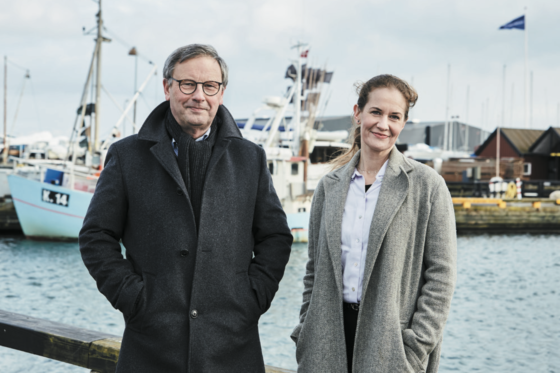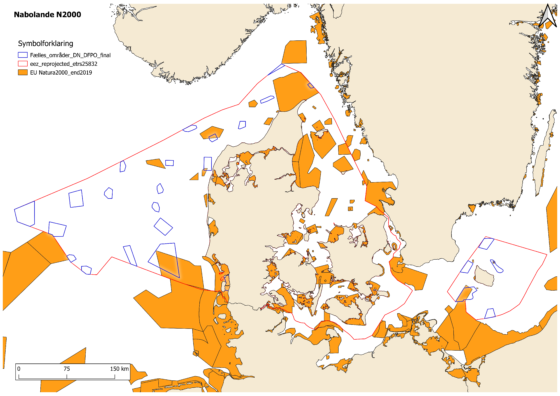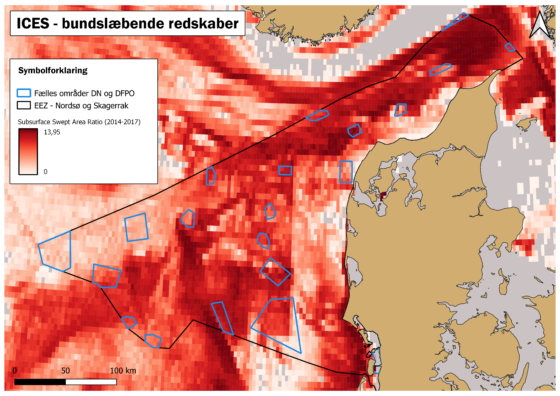
After months of negotiations, the Danish Society for Nature Conservation, DN, and the Danish Fishermen Producer Organisation, DFPO, present a historical proposal for ensuring a significant protection of the Danish sea. The proposal will ensure 10 percent untouched sea – no take Marine Protected Areas – in the North Sea, the Skagerrak, and the Baltic Sea, and is now handed over to the Danish government ahead of the Marine Spatial Plan negotiations. Decades of trench warfare between green organisations and the fishing industry is now put on hold. At least if it is up to the two big interest organisations.
Month long negotiations between the chairman of the Danish Fishermen Producer Organisation, Svend-Erik Andersen, and the president of the Danish Society for Nature Conservation, Maria Reumert Gjerding, have paved the way for a historical agreement, in which nature and business interests have bent towards each other and formed a detailed proposal for how Denmark can live up to the international targets of ensuring the designation of 10 percent untouched sea in the Danish North Sea, Skagerrak, and the Baltic Sea around Bornholm.
According to marine research, large, coherent, untouched sea areas without fisheries or any other commercial exploitation is one of the most important tools in order to restore the rich nature at the bottom of the sea.
The proposal is presented prior to the negotiations on the first Danish Marine Spatial Plan and second Marine Strategy, which will ensure the overall planning of all the Danish sea areas. At the same time, there is a process under the auspices of The EU Marine Strategy Framework Directive regarding the designation of protected marine areas in the North Sea, Skagerrak, and the Baltic Sea around Bornholm.
With the proposal, the two organisations aim to ensure a much better protection of the marine environment, and at the same time create a solid basis and framework for a more sustainable fishing industry, that will continue to contribute with jobs in the coastal areas and thereby strengthen the social cohesion in Denmark. If the increased protection of the sea areas causes significant, negative economic consequences for certain fishermen, the parties agree to recommend that politicians discuss the possibilities for a targeted support to the fisheries with focus on a sustainable transformation.

The chairman of the Danish Fishermen PO, Svend-Erik Andersen, is proud of the historical agreement, and hopes that the government will acknowledge the parties’ attempt to balance the business and nature interests in the forthcoming planning of the Danish marine areas:
– I am happy and proud that we have reached a successful agreement. We have worked with sustainability in the Danish Fishermen PO for years. A large part of our fishery is certified as sustainable, and we have reduced our CO2 emissions by 60 percent. With this agreement, we are taking another great step in a more sustainable direction, he says and continues:
– We prove that coexistence, where there is room for both nature preservation and the fishing industry, is possible when we listen to each other. We significantly boost the marine environment while respecting the jobs, that the fishery creates. We hope this will kick off an ambitious effort to strengthen the marine environment, where the major problems we experience with, for example, nitrogen and other types of pollution, will be addressed. That is also important for the marine environment.
The President of the Danish Society for Nature Conservation, Maria Reumert Gjerding, calls the agreement ground-breaking in terms of ensuring a far better protection of the nature in the sea:
– For decades, the nature in the sea has been in a sharp decline, where the fish population and life in the sea have suffered under a lack of protection. This agreement ensures that we have some large marine protected areas in the future where the marine nature can re-establish itself and be left in peace. It is ground-breaking both in a Danish and European context, and it is an important step on the road to solving the crisis of the sea – even though there is a long way to go yet, she says.
According to marine research, large, coherent, untouched sea areas without fisheries or any other commercial exploitation is one of the most important tools in order to restore the rich nature at the bottom of the sea.
Well under 1 percent of the Danish sea area is formally protected against any type of fishery. With the proposal, a total of 10.1 percent of the North Sea and Skagerrak as well as 10.3 percent of the Baltic Sea around Bornholm are designated as untouched sea – also known as marine reference areas.
Thereby, the two organizations lay the ground for a rather significant protection of the Danish sea areas. The EU’s 2030 Biodiversity strategy calls for better protection of European sea areas, by designating a minimum of 10 percent of the areas as untouched sea, and identifies this as one of the most important measures to take in order to curb the loss of biodiversity in the sea.
With the proposal, Denmark will become the first country in the EU to designate such a big share of the marine areas to be untouched and protected against fisheries and other recreational or commercial exploitation.
It evokes excitement at the Danish Society for Nature Conservation.
– Denmark has big and important marine areas. And as one of the richest countries in the world, we should of course live up to the international objectives about protecting the life in the sea. And here I would like to acknowledge the great goodwill we have experienced from the fishing industry to find balanced solutions. This proposal will attract international attention and help show the way for our European neighbours, Maria Reumert Gjerding says.
Increased protection of the sea makes good sense – also to the fishing industry, Svend-Erik Andersen explains:
– We want to show that we are a part of the solution. It is crucial for the future of the fishing industry that we have a healthy marine environment – that is what we live on. I would like to thank Maria and the Society for Nature Conservation for their approach to these difficult negotiations. For way too many years, the focus has been on the differences and the disagreements between nature and the fisheries. Here we have done the opposite, and we now stand with an agreement which is a new beginning, and which shows that there is room for a sustainable fishery in a healthy marine environment.
The agreement was presented on Wednesday at 11 AM by the Black Diamond in Copenhagen, where the Minister for the Environment, Lea Wermelin, and the Minister for Food, Agriculture and Fisheries, Rasmus Prehn, were present.

Facts: Together for the Sea
”Together for the Sea” is the Danish Fishermen PO and the Danish Society for Nature Conservation’s proposal for a better protection of the marine environment in the North Sea, Skagerrak, and the central part of the Baltic Sea around Bornholm, which is presented ahead of the forthcoming implementation of the EU’s Marine Strategy in the concerned areas.
- 10 percent of the North Sea, Skagerrak, and the central part of the Baltic Sea around Bornholm will be designated as untouched sea – so-called marine reference areas – and they will be protected against any type of fisheries and commercial exploitation.
- Even though there is no fishery in large parts of the sea, only 0.03 percent of the Danish marine environment is formally protected against any type of fishery.
- According to research, areas designated as untouched sea are necessary in order to secure the marine biodiversity and to monitor changes in the marine environment.
- With the designation of 10 percent untouched sea Denmark will be the first country in the EU to meet the objectives in the EU Biodiversity strategy in the concerned marine areas.
- The designation of the areas is based on the best available research and data, where the selected areas account for nature types, habitats and species that are poorly protected today or completely lack protection. That includes threatened species such as sharks, rays, and minke whales.
The agreement covers 26 areas with untouched sea in the Danish North Sea, Skagerrak, and the Baltic Sea around Bornholm